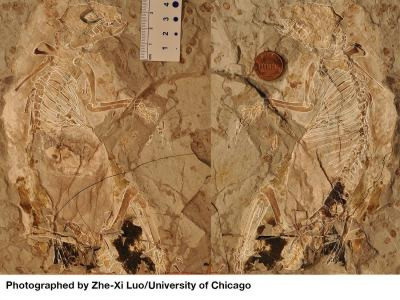165-Million-Year-Old Mammal Ancestor Fossil Found In China, Megaconus Mammaliaformis Had Fur [PHOTOS]


A fossil belonging to a 165-million-year-old mammalian ancestor sheds light on how adaptive features like fur and hair appeared before the rise of modern mammals.
The well-preserved fossil belongs to the Megaconus mammaliaformis, a nocturnal animal that likely lived on the shores of a freshwater lake in China. The skeleton is one of the best-preserved fossils of this mammaliaform group, which existed nearly 100 million years before the Tyrannosaurus Rex ruled the dinosaurs.
"Research always assumed that these were primitive and not highly specialized, but this animal shows that they were already highly specialized and highly adapted to special feeding strategies," Thomas Martin, a paleontologist at the University of Bonn in Germany and one of the authors of the paper, told LiveScience.
The fossil, now at the Paleontological Museum of Liaoning in China, contained a “clear halo of guard hairs and underfur residue” making it the second pre-mammalian fossil found with fur on it. The findings, published in the journal Nature, also describe how the fossil had a keratinous spur on the heel, leading scientists to suspect it was poisonous.
“This is very important because the presence of hair was always postulated, but the direct evidence was never well preserved in fossils," Martin told LiveScience.
Guillermo Rougier, a professor of anatomical sciences and neurobiology at the University of Louisville, who was not involved in the study, sees its pertinence. “The two skeletons just described are precisely the high-quality specimens that allow scientists to contrast and refine our basic understanding of the complex evolutionary patterns involved in the origin of mammals,” he told The Scientist, referring to the recent discovery and a similar one in 2006.
While the fossil shows mammalian traits, there are non-mammalian characteristics as well. A primitive middle ear remains attached to a jaw, and its anklebones and vertebral column are similar to other mammal-like reptiles.
The animal was approximately the size of a ground squirrel -- about half a pound – that ate both meat and plants and walked like a modern hedgehog or armadillo.
The Megaconus mammaliaformis was one of two newly discovered fossils detailed in the latest issue of Nature. The second animal, which most likely was able to climb trees, was probably a mammal classified within a broader group including the Megaconus mammaliaformis.
"To me, the most important part is, we know more about the morphology, more about the structure of this extinct group," Jin Meng, a paleontologist at the American Museum of Natural History in New York and an author of the second paper, told LiveScience. "Our knowledge of this extinct group has increased drastically."
© Copyright IBTimes 2024. All rights reserved.






















